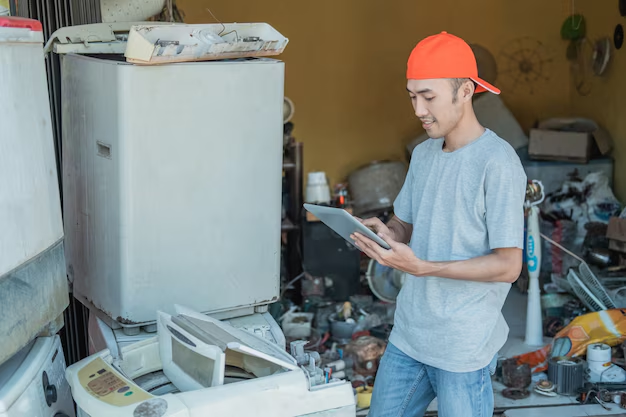Understanding Your Refrigerator's Power Usage: What Every Homeowner Needs to Know
Refrigerators are essential household appliances, faithfully keeping food fresh and beverages cold. However, they also represent a significant portion of household energy consumption. Understanding how much power your refrigerator draws can help you manage energy costs and enhance the efficiency of your home. Let's dive into what determines refrigerator power usage, how to measure it, and practical tips to optimize energy consumption.
📊 How Refrigerators Use Power
Refrigerators consume electricity to power their compressors, fans, and lighting. The main job of a refrigerator is to remove heat from its interior and release it externally. The power draw of a refrigerator depends largely on several factors:
- Model Type: Different fridge styles—top freezers, bottom freezers, side-by-side, or French doors—vary in efficiency.
- Age and Technology: Older models generally consume more power than newer, energy-efficient ones.
- Size and Capacity: Larger refrigerators naturally use more energy than smaller ones due to the greater space they need to cool.
- Insulation and Seal Quality: Effective insulation and quality seals help maintain temperatures efficiently, reducing power usage.
📏 Measuring Power Consumption
To fully understand the energy use of your refrigerator, you'll need to measure its power consumption. Here's how:
Using a Watt Meter
A watt meter, or kilowatt-hour meter, is a simple tool that plugs into your outlet. It calculates the power usage of any device plugged into it:
- Plug the watt meter into the wall outlet.
- Connect your refrigerator's plug to the watt meter.
- Monitor the readings over a set period (ideally a week for an accurate average).
Calculating Kilowatt-Hours
Most appliances, including refrigerators, provide power usage specifications in watts on a label inside or on the back. To estimate the energy consumption:
- Convert Watts to Kilowatts: Divide the wattage by 1,000.
- Example: 150 watts / 1,000 = 0.15 kW
- Estimate Hours of Operation: Refrigerators cycle on and off, but typically run around 8 hours a day.
- Calculate kWh: Multiply kilowatts by hours of operation.
- Example: 0.15 kW * 8 hours = 1.2 kWh/day
Multiply the daily kWh by the number of days in the month to determine monthly consumption.
⚡ Factors Influencing Energy Consumption
Various external and internal factors can affect your refrigerator's energy use:
Temperature Settings
Refrigerators should ideally be set to 37-40°F (3-4°C), with freezers around 0°F (-18°C). Setting temperatures too low can unnecessarily increase energy consumption.
Ambient Room Temperature
The room temperature can significantly impact how hard your refrigerator works. In hot weather or if placed near a heat source, it may need to cycle more frequently.
Quick Tip 🎯
Ensure your fridge is not near heat-generating appliances like ovens or in direct sunlight to maintain efficiency.
Frequency of Door Opening
Every time you open the refrigerator or freezer door, warm air enters, and the appliance must work harder to restore optimal temperature.
Loading Practices
Overloading your refrigerator can block air vents, and underloading reduces thermal mass, causing it to work inefficiently.
💡 Practical Tips to Reduce Refrigerator Energy Use
Adopting energy-conscious habits can significantly minimize your refrigerator's power draw without compromising its effectiveness.
Optimize Placement
- Ensure good ventilation: Allow a few inches of space around the unit for airflow.
- Avoid heat: Keep the refrigerator out of direct sunlight and away from the oven or dishwasher.
Regular Maintenance
- Inspect door seals: Ensure the rubber door seals (gaskets) are intact for an airtight closure.
- Clean coils: Vacuum the condenser coils twice a year to prevent dust buildup, maintaining efficiency.
Household Habits
- Minimize door openings: Plan what you need before opening the refrigerator.
- Defrost regularly: If not frost-free, defrost when ice becomes a quarter-inch thick.
- Organize: Keep items organized for easy access, reducing the door open time.
🤔 Choosing an Energy-Efficient Refrigerator
When it's time to replace your refrigerator, choosing an energy-efficient model can catalyze savings in both energy and money.
Look for Energy Star Ratings
Energy Star-rated appliances meet specific energy efficiency guidelines set by governing bodies. Using 10-20% less energy, they often include features that enhance efficiency further.
Evaluate Size Needs
Select a refrigerator size that meets your needs. Purchasing too large of a unit increases unnecessary energy draw, whereas too small a unit can lead to overfilling.
Modern Features for Efficiency
Many modern refrigerators feature:
- Inverter technology: Adjusts compressor speed based on cooling demand, optimizing power usage.
- Smart functions: Provide energy use data and diagnostics for proactive efficiency measures.
📃 Summary of Key Tips & Takeaways
To optimize your refrigerator's energy use, consider these simple and practical measures:
- 🌡 Set Ideal Temperatures: Keep your fridge at 37-40°F and the freezer at 0°F.
- 🏠 Position Wisely: Ensure proper ventilation and avoid proximity to heat sources.
- 🚪 Limit Openings: Open doors less frequently and close them promptly.
- 🛠 Conduct Maintenance: Regularly clean coils and check seals.
- 🌟 Choose Energy-Efficient Models: Opt for Energy Star-rated appliances with the right size and features for your needs.
By understanding and applying these insights into your refrigerator's energy use, you can make informed decisions that promote efficiency, sustainability, and cost savings. It's about more than just keeping your food cold; it's about using energy wisely in a way that benefits both the home and the planet.
